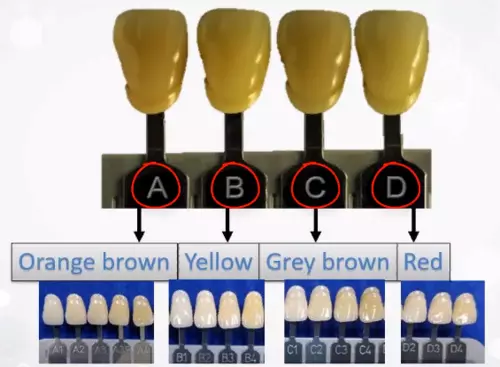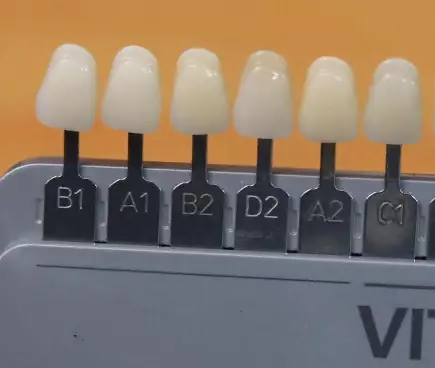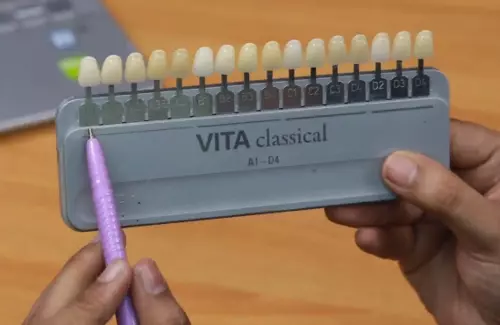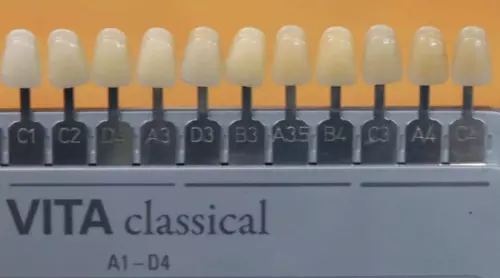Smiling at yourself in front of the mirror sometimes it seems that your teeth could be whiter and your smile could be prettier. How white can your teeth be? Would a whiter shade suit you or not? Let’s figure it out.
The dentin, the layer that can be seen through the enamel, determines the shade of the tooth. Young elements look whiter due to the thick dentin layer and irregular tooth surface – the light from it is not reflected fully, the dentin will not shine through as clearly. What tooth color is considered normal, how to determine it, restore, maintain, and will be discussed in this review.
How White Should Your Teeth Be?
“The right” white color for your eyes is easy to choose, although many people don’t know this simple method. You should look at the whites of your eyes in order to know the most suitable shade of white teeth for you. It is this shade of white that will harmonize best and the smile conveyed by your white teeth and eyes will be perfect.
The shade of a tooth depends more on the color or quality of the dentin and the density of the enamel. In adolescence, the layer of the outer protective shell (enamel) is much denser than in older people. The surface of the tooth is not completely flat, so light cannot be reflected evenly. The denser the enamel and the more pronounced the tooth microrelief, the whiter the teeth will look.
As we age, the dental crown becomes thinner and thinner, and the surface of the tooth becomes smoother. The dental hard tissue also changes – the dentin becomes darker. The brownish-reddish pulp may also show through. This makes the teeth look darker in older people.
You should also be aware that the tooth tissues have an uneven distribution of color. Most often, for example, the root of the tooth is darker and the incisal edge is white. At the same time, different teeth can also have different shades. For example, the incisors have a lighter shade than the canines.
What color can I whiten my teeth?
The American Dental Association says that brownish or yellowish enamel is the easiest to whiten. And shades of gray do not respond to this procedure.
How to choose the right tooth color?
One of the main tasks of the dentist is to help you choose the color of your future prosthetics. When restoring or denturing one or more teeth, the right shade is found based on the natural color of the client’s teeth. When making veneers or crowns, you can choose the color you like. When choosing, it is important to consider the color of the whites of your eyes, the color of your skin and even the color of your hair. In addition, it is necessary to be guided by the substance from which the orthopedic structures will be created. The shade of the materials may be different in different lighting conditions. A professional orthodontist can help you find the perfect color for your teeth, so that your smile shines even brighter.
Vita scale, why do they use it?
Vita scale (Vita or Vitascale) – the traditional scale of tones of visual perception of the shade of dental units. It has a kind of plastic rail with fixed types of tooth enamel (paper, plastic, cardboard, ceramic).
The rail is used to match the color of teeth for prosthetic appliances (crowns, prosthetic systems, plates) and to compare the results before and after bleaching procedures.
The doctor determines the shade of enamel in the following way: in turn, he puts each movable element of the rail to the fragments of the tooth row and finds out the similarity of tones.
Factors Determining Natural Tooth Color
If studies are to be believed, the color of the smile is primarily influenced by genetics, and then by a person’s place of residence and lifestyle.
More often than not, patients note the grayness of their teeth. This is caused by old fillings and deprivation of pulp units – the “dead” elements lose their natural shine and become grayish.
No less rare case is the yellow tone of enamel. This shade of enamel layer is inherited by the person. Yellowing of the dentin can be seen through very thin enamel. It is normal for teeth to turn yellow as they age.
Causes of loss of natural tooth color

Dentists have identified several of the most popular reasons for patients changing the original white color of their teeth to darker shades:
- Pathologies of internal organs (stomach, pancreas, etc.);
- Carious lesions of the elements of the rows;
- Abuse of coloring products (coffee, strong tea, cocoa);
- Consumption of certain medications (tetracycline antibacterial drugs);
- smoking;
- lack of compliance with the rules of personal hygiene;
- Low bone strength;
- deficiencies, excess of vitamins in the body.
Since the above factors do not cease to be active in people’s lives, there are very few owners of a naturally white smile in the world.
The color of baby teeth in children
The color of a child’s smile is established as early as intrauterine development. Baby teeth are white. Change the shade of the elements not for the better may be iron preparations (at the end of the therapeutic course the whiteness returns).
Excessive fluoride is the cause of the graying of temporary teeth, they become rough and covered with spots. Dentists see the solution to the problem in the purchase of a filter to reduce the concentration of fluoride in the water, the use of toothpaste without the mineral.
Antibiotics and products containing artificial dyes are not good for the color of baby teeth.
How to restore the color of your smile?
The algorithm for restoring the lost whiteness of teeth is traditional. At the first stage, the doctor excludes the fact that the patient has developed chronic pathologies that can cause discoloration. If possible, they are to be treated and achieve a stable remission.
Teeth whitening follows. Our dentists choose the method of whitening together with the patient. The choice depends on the condition of the tooth enamel, age, health, wishes and financial capabilities of the person.
An alternative to bleaching is the installation of veneers and lumineers. The procedure of restoring the elements using photopolymer materials is also effective. The measure helps to “disguise” cracks, irregularities, stains on the units. This method is not recommended only for weakened, inflamed roots, if the tooth is highly mobile.
The final step is to take preventive measures to maintain the whiteness of the teeth.
Will the B1 tooth shade be good for me?

The shade of the B1 scale is the lightest and the majority of the population has slightly darker teeth (A3 is statistically the most common shade). Therefore, making a hasty decision to give your teeth the B1 shade may disappoint you in the future. Unnaturally white teeth can not only look strange, but in some cases repulsive. Above in the article we already explained how white your teeth should be.
How to maintain the white color of teeth: tips from dentists?
To maintain the white color of the teeth, doctors recommend following a few simple rules:
- Brush your teeth twice a day (morning and evening) for at least three minutes, using a paste with fluoride, calcium compounds.
- Do not brush your teeth too hard, do not use bristle brushes. Do not use abrasive toothpaste more than twice a week.
- Do not brush with baking soda, salt, chalk or other ingredients not intended for that purpose.
- Limit consumption of sweets, sodas and energy drinks. Rinse your mouth with water after sweets.
- Include in your diet more solid foods, which increase salivation and promote mechanical cleaning of the tooth surface.
- Quit smoking, including hookahs.
- Avoid sudden temperature changes in the mouth.
- Visit your dentist regularly (once every 6 months).
Q&A
How much can teeth whitening negatively affect the health of my teeth and gums?
In general, teeth whitening is a safe and painless process. Especially if you are simply returning your teeth to their natural color. However, attempting to aggressively affect the enamel with severe darkening can cause teeth to become overly sensitive to cold, hot, acidic, etc. Therefore, if you know your teeth/gums are sensitive, warn your dentist before agreeing to the teeth whitening process.
Can yellow teeth become white?
Yes, modern dentistry can restore a lighter color to your teeth. Moreover, if your natural tooth color is too yellow, too dark, that too can be corrected. However, in each individual case, the way you whiten your teeth is chosen by your dentist.
Why are my teeth still yellow after whitening?
If you think your teeth are still yellow right after whitening, ask your dentist this question because he or she can better explain the reason your teeth are yellow based on the whitening method you and he or she chose. However, if you are upset by the fact that after whitening your teeth became yellow again over time, then in the vast majority of cases the reason lies in your oral hygiene, food, drink and habits that can negatively affect the whiteness of your enamel. Pay special attention to these points.
Can some teeth not be whitened?
Depending on the whitening method, teeth can be whitened as a whole (all together) or individually. Also, note that you cannot whiten crowns, fillings or other materials that were used to restore or replace your teeth. In this case, dentistry offers other methods.








